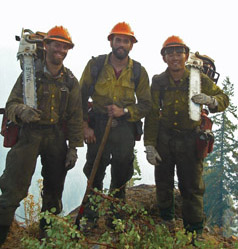Now Is The Time To Apply For The Best Summer Job Ever : Wildland Firefighter
Seasonal Wildland Firefighters : Applications and Physical Conditioning
So you want to be a seasonal wildland firefighter this summer? Great! January and February is the best time to apply. First, you need to be in shape. Got that covered? The test, known as the Work Capacity Test or the Pack Test is arduous. You will be expected to walk ( not run) three miles in 45 minutes while carrying 45 pounds on your back. Trust me when I tell you that the 45 pounds adds a whole lot of challenge to this test. If you think you are too old or maybe just too out of shape to pass the physical requirements, then you need to keep reading. Every wildfire and even other incidents require plenty of behinds the scene workers in the areas of logistics, plans, operations, finance.
Seasonal Wildland Firefighters

Seasonal Wildland Firefighting : Knowledge and Applications
Once you have decided that you can successfully complete the annual work capacity test, you will need to show that you have the successfully completed the National WildFire Coordination Group's ( aka NWCG ) Basic Firefighter and Introduction to Wildland Fire Bahavior ( S130/190) courses. Some agencies will expect you to have already completed this prior to being accepted into their summer program. Other agencies will provide you with this forty hours of instruction. It can be taken online as well.
The next step is to find agencies that are hiring seasonal wildland fire fighting personnel. If you are looking for a federal job with an organization like the Department of Interior's National Parks, the Department of Agriculture's US Forest Service, Bureau of Indian Affairs, etc, then you need to apply at the USAJOBS website.
Another option is to see if your local fire departments or fire protection districts are hiring volunteer or seasonal fire fighters. This is very common in the western United States such as Colorado, Montana, California, etc. I can already hear the comments that go something like "but I don't want to volunteer, I need to get paid". I personally know volunteer seasonal fire fighters who have made over $100,000 during active, prolonged, fire seasons. I will tell their personal stories in another article. Here I will just cover the process of how it is done.
Best Use of Breaktime from Fire Training

How To Make Money As A Seasonal Volunteer Firefighter
The first step to making money as a seasonal wildland firefighter is to become a NWCG certified wildland firefighter. There are three basic requirements for this. First, you need to be physically fit enough to pass the arduous Work Capacity Test, also known as the NWCG Pack Test. In short, you need to be able to walk 3 miles in 45 minutes carrying a 45 pound pack on your back. The next thing you need to do is complete the NWCG S130/190 coursework. The third requirement is to find yourself a "home unit". A home unit is an agency or local fire department that will bring you on as a volunteer or seasonal employee. This home unit needs to enter your training, certifications, and fire experience into an online national database known as the Incident Qualification System ( IQS) and the Resource Ordering And Status System (ROSS). This home unit will be where you get your pay checks from. In some areas, the USDA US Forest Service will accept seasonal employees as what they refer to as AD employees. AD stands for administratively determined. Just think of AD employees as "on-call as needed" employees of the US Forest Service.
Wildland Firefighting Gear
Almost Anyone Can Be A Paid Seasonal Fire Employee
Before we end, I want to touch on a piece of information that far too many people seem to know. The wildland fire management community, now growing into what is becoming known as all-hazard incident management, as it involves all types of disasters employs many non-arduous people as well. The incident management teams need everything from food unit leaders, to communication experts, simple radio operators or drivers. I, myself, have been employed on some large incidents to do nothing but drive a 4x4 pickup to destinations carrying people and/or supplies.
While the tasks that each of these positions require is vastly different, the point of getting "into the system" is very similar. The first warning that I give to everyone who is interested in pursuing this adventure is to make sure they are willing to set up a tent and sleep on the ground for up to 14 days straight. Often hotels or other sleeping arrangements are available, but not always. Be prepared and pack accordingly.
I always recommend that even if you aren't going out as an operational fire line firefighter, you either take S130/190, online or in person. The added understanding of the lingo and such is very valuable. I also encourage everyone to at least get out and exercise. Maybe this means just taking a short 1 mile walk every day. Trust me when I say it makes putting up a tent, sleeping on the ground, or just walking around a fire camp or incident command post that much easier. Find a good home unit. A home unit that already understands and actively supports the IQS and ROSS systems will be able help you immensely.
All of the diversely different positions that the incident management system has is covered in NWCG's 310-1 manual. The direct link to the Position Qualifications Flowcharts are on pages 181 thru 191.









